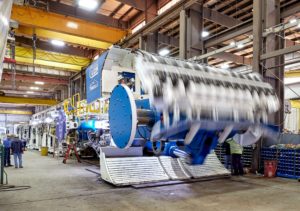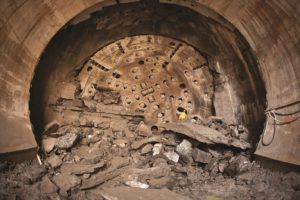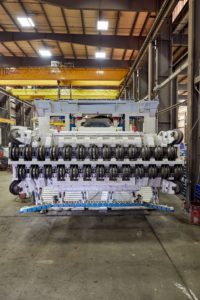At MINExpo 2021, IM Editorial Director Paul Moore met in person with Robbins Owner and CEO Lok Home, to explore the potential for civil tunnelling and mining to finally come together through the hard rock excavation benefits of TBM technology adapted for the mining space.
If anyone understands the proven performance of hard rock mechanical excavation, and has seen most of the ups and downs of previous attempts to apply it in mining over the years, it is Robbins’ Lok Home. “I’ve been in mechanical excavation for my entire career – I joined Robbins in 1968, then acquired the company in 1989. Even in the 1980s at Robbins we were trialling a Mobile Miner with Mount Isa – we also had shaft boring machines and the main achievement was introducing raise boring to mines. The raise boring business was later sold to Epiroc. As a result of this historic business we are very mine-savvy I would say as a company. That said, despite over 40 years of experience, neither we nor the other players have managed to make a really big impact in mining with mechanical mining methods. Finally, I think we are seeing a switch in attitudes with the mining companies with it becoming more accepted, but at the same time it is still largely limited to trials.”

Lok Home, Robbins Owner and CEO
Home points out that if you had a 5 km, 20 ft diameter road tunnel you needed to excavate in hard rock – a civil construction company would today never even consider drill and blast – they would always use a TBM. At any one time there are several hundred TBMs boring civil tunnels around the world – with the average one probably having tunnelled 10 km – that’s a lot of rock. “Why? Because it is faster and cheaper. The mines up to now haven’t accepted mechanical excavation as a really serious option – to them it’s been a kind of experimental tool. Their first reaction to a TBM is how am I going to get it underground – they want something similar to a mobile miner that gives the benefits of a TBM but lets them mine how they’ve always mined. But that’s not the answer in my view – yes we can give them some additional machine mobility but to make it work they have to go some way towards rethinking their mining process.”
But Home says step changes in mining are now happening, some of which is being driven by environmental concerns. “I was invited to join an ICMM session on reduction of tailings – they had identified mechanical excavation of rock as one method of more selective development and ore mining, rather than taking out large volumes of waste.”
Mine development is all about reaching first ore quicker, and then economically mining the orebody while reducing tailings. So it is first and foremost about productivity and in this race, mechanical excavation can outpace drill and blast.
And there are new mining companies looking at the potential. “We are looking at a project in Kazakhstan where a mine wants to achieve faster development, including looking at shaft boring machines and driving declines with a TBM. We took them to see a civil tunnelling project in Turkey using a 14 m machine boring in hard rock – that machine in one month produced 330,000 t of rock – more than twice what the mine produces and with a fraction of the workers. We clearly aren’t going to put a 14 m diameter TBM in their mine, but the comparison just shows the capability of hard rock mechanical excavation.”

The Robbins MDM5000 delivers a rectangular drift with a flat floor
So, how can the two industries meet in the middle – civil construction and mining – so the mines can get the benefits of our technology? There is no doubt Robbins can excavate rock significantly cheaper with mechanical excavation than with drill and blast in the right scenario, but with some tweaks. “The mines don’t want round tunnels, and of course that’s what we are best at. So to address that we developed our unique MDM rectangular tunnel boring machine to meet mining halfway – it gives you a nice flat floor on which you can drive all your vehicles efficiently and immediately, and it produces a defined space without the typical 15-20% of overbreak with conventional drill and blast.”

Hard rock Robbins TBM breakthrough at Niagara Tunnel
By September of this year at the Fresnillo mine in Mexico with a 5 m by 4.5 m MDM5000 machine, Robbins had achieved more than 1,700 m of advance at rates up to 52 m in one week and 191 m in one month, so the MDM has already shown that it is significantly faster than drill and blast excavation. The MDM5000 is also excavating in andesites and shales with quartz intrusions that have defeated earlier attempts to excavate these tunnels with heavy roadheaders. “One reason we are working with Fresnillo is their commitment to work closely with us on the project and the machine’s central role in their future plans. Often in the past major mining houses have reached out wanting to work on a machine purely from an R&D standpoint – but for a complex machine like this, it isn’t enough. We don’t want our machine to be sitting in a corner as an expensive experiment.”
At Fresnillo, Robbins has shown the required excavation rates are achievable; and the scope of project has been widened significantly due to its performance – at the start they wanted a straight 4.5 km tunnel only – then this evolved into boring a 360° spiral to end above the original tunnel – a distance of over 4 km. It will then be backed up to the original tunnel and continue driving straight ahead. Like any project of this type there have been challenges – notably dealing with a lot of ore veins – which slowed progress due to unstable rock zones and high water inflows – but the machine is still at the heart of their operations. “When the rock was consistent we went up to three times faster than drill and blast – over 185 m in a month versus 60 or 70 m.” Robbins also took a delegation from Kazakhstan to see the Fresnillo machine working.

MDM5000 cutter head
The advantages of neat and profiled tunnelling are many in mining – “especially if you want to use autonomous equipment, but also in fitting infrastructure – from lighting to comms networks to compressed air and power cabling; plus we are 100% rockbolting and wire meshing as we go, vastly reducing the time spent in getting rock reinforcement teams to come in separately. And of course there is no blasting so no need to lose time in between blasts or to have explosives stored underground. It is also supersafe as a result – there is no one out in front of the machine. And the material as in a TBM just gets conveyed out – no need for secondary crushing, loaders or haulage trucks.”
The incline limits Robbins has set are the same as for a truck decline – about 12-15%. Aside from the MDM Home said Robbins is also working on vertical shaft boring – “we are working on finalising an order for such a machine in the coming months in fact. And we are doing some remotely operated incline boring with TBMs on hydro projects, which can have some application in mining. The continuous miners out there have done well in soft potash but are roadheader technology limited in harder rock– there is no question that with disc cutters, we can handle up to 300 MPa rock – you slow down but you don’t stop when using disc cutters.”
And back to declines – for long, straight declines in mining there is huge potential – “of course as access tunnels but these are also well suited to autonomous haulage of ore, with some mines looking at having two declines to allow for one way traffic loops of autonomous trucks. Our decline project at Anglo American’s Grosvenor coal mine in Australia remains a standout one in the industry.” It involved an 8 m diameter Robbins Dual Mode ‘Crossover’ TBM and continuous conveyor system. The Robbins’ TBM bored two decline access tunnels at grades of 1:6 and 1:8, one for conveyors and another for people and equipment.

Launch of Robbins TBM at Anglo American Grosvenor
Home ended by reiterating that mining is changing and becoming less conservative. “And it is becoming more progressive – with free trials leading to a decision to buy a new machine or not. Today, many more mines are working with suppliers to achieve the best solution together but with more of an upfront partnership to share both risk and benefits.”











